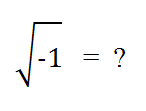Welcome to Fractal Week!
As you may recall from last Wednesday, the creature above is known as the Mandelbrot Set. It is perhaps the most famous fractal in existence: beautiful, mysterious, elegantly simple yet infinitely complicated.
But what is the Mandelbrot Set, really? How was that image created? What mathematical equations govern this bizarre object?
This week, we’re diving into the math. My goal is that, by the end of the week, every one of you will understand how this fractal works.
Before we can get to the fractal itself, we need to lay some foundations. So today we’re going to start by explaining…
Real, Imaginary, and Complex Numbers
The real numbers are simply the numbers we normally use for math all the time. Positive numbers, negative numbers, integers, fractions, decimals. 3, 77, 864.52, -18, 0. These are all real numbers.
Today we’re going to move past the real numbers into the so-called “imaginary numbers.” Don’t let the name fool you – imaginary numbers are one of the most important and useful concepts in modern mathematics, with applications far beyond fractals. This is good stuff, I promise.
So, what is an imaginary number?
Let’s start by talking about square roots. You’re probably familiar with these already. The square root of 25 is 5, the square root of 49 is 7, the square root of 1 is 1, and so on. You’re simply finding a number that squares to equal another number.
All right. So what’s the square root of negative one?
The square root of negative one isn’t just negative one, because negative one squared gives you positive one. In fact, it turns out that no real number can be squared to give you negative one, or any other negative number. It just isn’t possible.
So to answer this question, mathematicians invented an entirely new number, an “imaginary number,” called i.
The equation above, the meaning of i, is the most crucial thing for you to learn today.
It’s important to understand, i is not a variable like x or y, that we can give different values or somehow “solve for.” Nor is it a number like pi, which has a specific real value that we can write out, 3.14159265… There isn’t a real number secretly hiding behind i. Rather, we’ve invented an entirely new number, completely outside the real numbers, in the same way that Paris is completely outside England.
What is i? It’s the square root of negative one. That’s the only possible or meaningful answer.
This may seem weird at first, because we’re used to thinking of numbers as quantities. If I want to understand the number 5, you can give me five apples as an example. I can have zero apples, or 2/3 of an apple. In a way, I can even have -1 apples, if you take one from me. But there’s just no way I can ever have i apples, because i isn’t a quantity.
So rather than trying to imagine something impossible, let’s just see what kind of math we can do with this new number.
In most ways, i acts like any other number. It’s pretty well-behaved. For example, here are four random little equations that give you a sense of how i operates.
Hopefully nothing too surprising there, if you’ve done much algebra. But i would be pretty useless if it acted just like every other number. The one thing that’s special about i, as we’ve already said, is that it’s the square root of negative one. Turning that around, we realize that:
This little fact means we can figure out more complicated expressions, like…
What if we take i to the third power? We can use our knowledge of i to figure out that one too…
Okay, hopefully that made at least a little sense, and now we have some idea what imaginary numbers are. What’s next?
Well, we started today by looking at just the “real numbers,” the ordinary numbers we’re familiar with. Then we added in these “imaginary numbers” that involve i, vastly expanding our concept of what a number is. To include this new, broader concept, mathematicians needed a new name. So the set of all these numbers, real and imaginary and every possible combination of the two, is known as the “complex numbers.”
I’ll say that again, because it’s important:
The complex numbers are the set of all real numbers, imaginary numbers, and anything you get by combining them together.
So, for example, all of these are complex numbers: 15, 0, -6.2, i, 5i, -i, i + 3, 4.8 – 7i.
Whew! That was a lot to cover in one day. So tell me: did it make any sense? I’ve never tried blogging a math lesson before, so I hope you’re not totally lost. If you are totally lost, please don’t give up! Ask your questions in the comments and I promise I’ll do my best to answer them.
As a test of your new knowledge, see if you can figure this out:
I’ll post the answer in the comments, but see if you can figure it out yourself before you look!











The answer is 7. If anyone has questions about how I got that, let me know and I’ll be happy to explain!
I know! The answer is 7! Partly because you told me… also I knew. Here’s one. Integrate -> e^(ix)cos(x)dx. Infinite bounds!
Damn, son! It’s been five years since I had to do an integral, and even back then, I’m pretty sure I couldn’t have done a complex one.
You’ve got me curious. How do you find the answer?
Actually complex integrals are super easy. If you use Euler’s Identity you can turn the Cosine into a two complex exponents. (e^(ix) – e^(-ix))/2 Then you just have to take the integral of e^((x^2)) which is a standard Gaussian Integral. Now the Gaussians can be tough. Usually you look them up, but if you transform it to polar coordinates it takes about 6 seconds to solve. This is a common integral in the world of Quantum Mechanics.
Friggin’ Gauss…just because he’s among the most prolific geniuses of all time, he gets everything named after him? C’mon. Where’s the Buckleyan Integral?
Buckleyan integral -> Bounds, (tall, ridiculously tall) – Function, (karate*programming*math)*dkarate *dprogramming *dmath = The Brian of Buckley
As a Buckley, I find this comment extremely offensive.
I should be at *least* a quadruple integral.
Good explanation, although coming from such a high math background it feels a little patronizing. I would have greatly prefered reading this in high-school than a text book though.
Heh, yeah I knew this would all be review for you and Ben. We’ve got some young’uns in the audience, though.
Dammit!
I was sure the answer was ‘Purple’
Oh, sorry! You must have been thinking of “What is the airspeed velocity of an unladen swallow?”
Lol, don’t worry about my comprehension of math. I may only be a freshman, and thirteen too, but I’m in one of the most advanced programs in the country. I take algebra two honors in fourth period. I understand all of this, and it’s also a review from earlier in the year so it’s fresher in my mind.
Glad to hear it. Everyone gets things at a different speed, though, so I’m trying to take it one step at a time.
I now feel extremely dumb. I’m thirteen too (in grade eight, though) and despite my math achievements- second in my school district for a big fancy nation-wide math test (I’m talking about Canada here- the country with the education system that’s supposed to be really awesome)- first in my school, and a knowledge far above what most eighth-graders have, I’m still not sure if I’ve got this.
It’s i x i x i x i, right? So… i x i is -1, which, x i, is -i. So that’s i x i x i. Times i one more time is i to the fourth power, which is what I need. So, -i x i must be 1. With normal numbers, a negative times a positive is a negative. And this is the opposite pretty much, right?
I’m very uncertain about whether or not I figured it out properly. I fiddled around with it for about five minutes, didn’t solve it, scrolled down, re-read everything, and started to think that I might be starting to understand it, but I’m not sure at all.
Hey Evlora! I’m glad you commented. I was starting to think NOBODY would be brave enough to admit they didn’t completely understand. The general rule is that for every person asking a question, there are five more people with the same question who just keep their mouths shut. And by the way, complex numbers are way, way beyond a typical eighth-grade curriculum, so you shouldn’t feel dumb at all.
You’re right, i to the fourth power is 1. All the equations you mentioned are correct. Specifically, both of these are right:
i x i x i = -i
-i x i = 1
It sounds like the place you struggled a bit was with doing -i x i. Here’s the easiest way I’ve found to think about it:
-i x i = -1 x i x i = -1 x -1 = 1
In other words, separate out the negative sign, multiply the second pair of i’s, and then just multiply -1 x -1 like normal.
Does that help at all? Let me know if I didn’t explain it well.
I agree with Adam. This is better than any textbook I remember reading. I’m thinking about doing a non-math based fractal week for those inclined to draw. Despite Mandelbrot’s fame, fractals were around for a century before he dabbled. Anyone interested?
Thanks Ben! I would totally be up for a non-math fractal week. Make it so!
Pingback: Preview: Fractals You Can Draw | Ben Trube
I got the right answer! Since I haven’t taken a math class in more than 20 years, I consider that a huge accomplishment–for both me and you. Great job on the math-lesson blog! I look forward to reading the rest of the series 🙂
Nice work! Anytime you do math involving complex numbers, it merits at *least* a smug eyebrow lift of satisfaction. 🙂